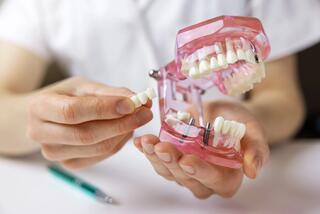When it comes to replacing missing teeth, dental implants are one of the most reliable and long-term solutions. They not only restore the functionality of the dental arch but also provide natural aesthetics to your smile. In this text, we will cover what a dental implant is, the different types available, and how the installation process works. So you can make an informed decision for your health!
What is a Dental Implant?
A dental implant is an artificial tooth root that is placed into the jawbone and serves as a foundation for future prosthetics. Thanks to the high biocompatibility of materials such as titanium and ceramics, the implant provides a stable base for crowns, bridges, or removable dentures, ensuring long-lasting stability and comfort.
Types of Dental Implants
By Material
-
Ceramic Implants: An ideal option for patients with metal allergies, providing high aesthetics, especially in the front teeth area, as they do not show through the gums.
-
Zirconia Implants: Biocompatible with high strength and aesthetic properties, suitable for placement in both the anterior and posterior regions.
-
Titanium Implants: The time-tested standard—strong and durable. Titanium is widely used in medicine, confirming its safety.
By Bone Fixation
-
Ceramic Implants: An ideal option for patients with metal allergies, providing high aesthetics, especially in the front teeth area, as they do not show through the gums.
-
Root-Form Implants: The most popular type, mimicking the shape of a natural tooth root and fitting well for most patients with sufficient bone volume for placement.
-
Basal Implants: Used in cases of significant bone atrophy without requiring bone grafting, as they are fixed in the deeper layers of the bone.
-
Zygomatic Implants: Applied in severe upper jaw bone atrophy cases, anchored in the zygomatic bone to ensure secure fixation even in complex situations.
By Construction Type
-
One-Piece Implants: A single, integrated structure that includes both the abutment and the root part. These implants can be loaded with a temporary crown immediately.
-
Two-Piece Implants: The root part and abutment are placed separately, allowing for separate implantation and prosthetic procedures, which is convenient for complex clinical cases.
Stages of Implant Installation
Single-Stage Implantation
-
Preparation and Diagnosis: An examination, X-ray, or CT scan is conducted to assess bone condition and determine the optimal implant placement.
-
Implant Placement: The implant is inserted into the bone under local anesthesia.
-
Temporary Crown Fixation: Done either a few hours post-surgery or 3–7 days later, depending on the clinical situation.
-
Permanent Prosthetics: After the implant has integrated (3–4 months in the lower jaw or 4–5 months in the upper jaw), a permanent crown made of metal-ceramics, ceramics, or zirconia is placed.
Two-Stage Implantation
-
Preparation and Diagnosis: Similar to the single-stage procedure, a thorough diagnosis evaluates the bone volume and quality.
-
Implant Placement: The implant is fixed into the bone and is covered by the gum to allow for healing and integration.
-
Osseointegration: The implant is left to heal for 3–6 months to ensure complete fusion with the bone.
-
Placement of the Healing Abutment and Abutment: After full integration, a healing abutment is placed.
-
Permanent Crown Fixation: A permanent crown is fitted, completing the prosthetic process.
